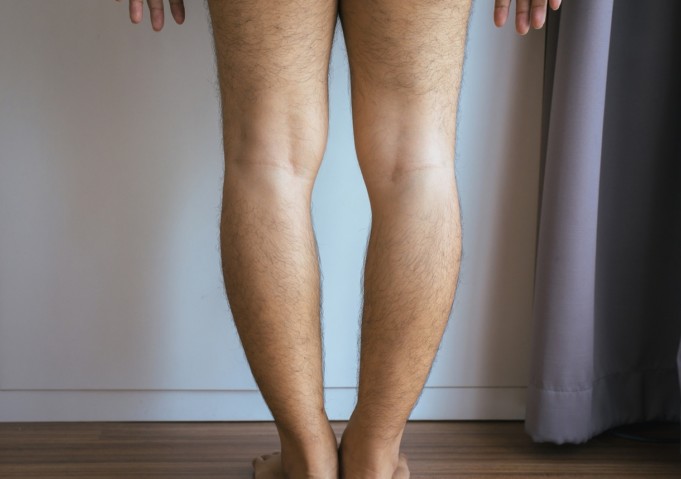Blount’s disease is generally referred to as a growth disorder that affects the tibia (shin bone). This disorder causes an inward bend or curve of the lower leg, resembling a bowleg.
Bowlegs is a condition that affects a person’s legs, making them appear bowed out. Meaning their knees stay wide apart even when their ankles are together). It is also known as “tibia vara”.
It is coined after Walter Putnam Blount (1900–1992), an American orthopaedic surgeon. This condition is also known as Mau-Nilsonne Syndrome, named after C. Mau and H. Nilsonne, who published early case reports of the condition.
Blount’s disease is mainly found in children, and it affects the growth plates around the knee. The abnormality causes the growth plate near the inside of the knee to either slow down the growth or stops producing new bones.
However, the growth plate close to the outside of the knee doesn’t stop growing. This results in a bowlegged appearance that affects one or both legs. Erlacher was the first person to describe a case of tibia vara in 1922.
Walter Blount wrote about the disease in 1937 in an article detailing 13 children with tibia vara or osteochondrosis deformans.
Causes
The exact cause of Blount’s disease is yet unknown, but it is suspected to be caused by excess weight on the growth plate (the inner part of the tibia).
Some children with infantile Blount’s disease are typically early walkers (prior to 12 months) and are often overweight. The growth of the inner region of the tibia would be affected, which can cause angulation to the bone.
While adolescent Blount’s disease may be related to obesity or rapid weight gain, it is also believed to be a genetic component. Blount’s disease tends to run in families.
Symptoms of Blount’s disease
Children suffering from Blount’s disease will have bowing of one or both of their legs that may be:
- Appear asymmetric
- Be rapidly progressive
- Primarily occur just below the knee
The condition called tibia vara is also known as genu varum. Some, particularly adolescents, may also complain of knee pain or instability.
Types of Blount’s disease
1. Infantile Blount’s disease
Bowlegs are relatively normal in children under the age of 2 and typically improve by 18 – 24 months. Infantile Blount’s disease appears around the same age, but the bowing does not improve and instead worsens over time.
Other characteristics of Infantile Blount’s disease that can help early detection can include the following:
- Happens to children between the ages of newborn to 3 years old
- Generally occurs in both legs (bilateral)
- Deformity happens in the tibia (shin bone) only
- More common than the adolescent type.
2. Adolescent Blount’s disease
The problems with most patient suffering from Adolescent Blount’s Disease is that they are often quite large both in height and in weight. Unfortunately, obesity plays a major role in the development of Blount’s disease, and it affects children of all ages, especially in adolescents.
Early detection of Adolescent Blount’s disease may include any of the following:
- Happens to children over the ages of 10
- The effect may be one-sided (unilateral)
- Deformity generally affects both the thigh bone (femur) and the tibia.
Diagnosis
Blount’s disease can be diagnosed by physical exam and X-ray. Your doctor would have to physically examine patients suspected of having Blount’s disease.
Treatment
Treatment for Blount’s disease differs, depending on the severity of the condition. Some conditions of Blount’s disease demand nonsurgical treatments, while others need more extensive attention.
Nonsurgical treatments
The best solution is to deal with the disease at an early stage. Children who suffer from severe bowing before they reach the age of 3 may be treated with knee ankle-foot orthoses.
Bracing affected parts of young patients suffering from infantile Blount’s disease is an effective way of controlling the condition.
Bracing is done to guide the legs into a more aligned position. This should be in early so that improvement becomes progressive as the child grows. Patients may require surgery if correction isn’t done quickly. Consult with your doctor to discuss your options.
Surgical treatment
Surgery might be the solution for some cases (older or adolescents). This involves cutting the shin bone (tibia) to realign it, and sometimes lengthen it as well. The primary focus is to correct the deformity caused by the disease.
This helps to improve the alignment of the affected legs. Surgery may be needed if bracing doesn’t deliver desired results.
Extreme cases of deformities and people who braces won’t or no longer work for may require surgery. Surgeries that can be done to treat Blount’s disease, including hemiepiphysiodeses and osteotomies.
- Hemiepiphysiodesis: This is done to corrects the deformity with time. It involves inserting staples or plates on one area of the growth plate to discontinue the growth on that side. The inserted plate guides the growth of the bone into a straighter position while the non-plated side continues to grow.
- Osteotomy: This involves cutting and realigning the affected bone. Doctors then take their time to put the bone in a better position. This surgery typically corrects significant deformities quickly.
Outlook
After treatment, most children resume normal activities with little to no issues. Nevertheless, the child must continuously visit an orthopaedic doctor who would examine his or her growth.
This is important to accurately monitor any possible complications, such as differences in leg lengths or more.
A healthy weight should also be maintained to properly manage the disease. This helps to minimize the potential damage that may affect the joints with time.
Sources;
Blount’s disease; Wikipedia












